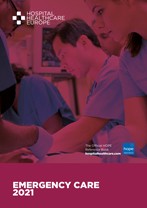A positive CT-PA and haemoptysis were the only factors associated with meeting the 4-hour waiting target for ED patients with a PE.
A venous thromboembolism, which includes both deep vein thrombosis and pulmonary embolism (PE), is the third most common cardiovascular disease with an overall incidence of 100–200 per 100,000 people.1 Moreover, a PE is potentially life-threatening and because the condition lacks a specific set of symptoms, the diagnosis has become heavily reliant on non-invasive imaging. In fact, CT-PA is now recognised as the gold standard for the diagnosis of a PE.2 Left untreated an acute PE has a mortality rate of up to 30% and potentially up to two-thirds of patients with a PE can die within 2 hours of presentation.3 Thus, a prompt diagnosis can have a significant impact on mortality and in fact, some evidence suggests that longer waiting times with an emergency department (ED) are associated with
a greater risk in the short-term, of death and admission to hospital.4 The introduction of a 4-hour target in ED therefore seeks to reduce the time patients spend in the department.
However, the need for a CT-PA scan might increase the overall time spent within the ED and therefore breach the 4-hour target. Although clinical care should not be driven solely by the need to achieve a time-based target, a team from the Department of Radiology, Salmaniya Medical Complex, Bahrain, Saudi Arabia, wondered if there were specific patient or environmental factors which might influence the duration of stay in the ED. They undertook a retrospective analysis focussing on patients presenting with a suspected PE and for whom a CT-PA scan was performed.5 The team sought to identify which, if any, patient or environmental factors were associated with meeting the hospital’s 4-hour target. They collected patient demographic and clinical data as well as the time of presentation and deposition, calculating the length of stay in ED as the difference between these two times. Multivariate logistic regression analysis was used to determine independent factors associated with meeting the 4-hour target.
Findings
A total of 232 patients (32.8% male) of whom 80.2% were under 50 years of age, presented at the ED and underwent a CT-PA scan to rule out a PE. Overall, only 14.6% had a PE and a D-dimer assay had been requested for 59.1% of them. The overall median time to deposition from the ED was 5.2 hours and the only clinical factors that were significantly associated a lower time to disposition were the presence of hypoxia (p = 0.04) and an altered level of consciousness (p = 0.01). The time to deposition was longer among those who had a D-dimer test but this difference was not significant (p = 0.43). Overall, patients found to have a PE in the CT-PA scan also had a significantly shorter duration of stay in the ED (p = 0.02). Another factor which influenced the duration of stay was the day on which patients were seen, with those who attended at the weekend having a shorter length of stay (p = 0.01).
In the multivariate regression analysis, only two factors were independently associated with a stay of under four hours. The presence of a positive CT-PA scan (odds ratio, OR = 2.2, 95% CI 1.1–4.8, p = 0.02) and the haemoptysis (OR = 10.4, 95% CI 1.2–90.8, p = 0.03).
Commenting on these findings, the authors noted that while guidelines suggest that a D-dimer test is performed before a CT-PA scan, performing this test only added around 30 minutes to the overall time to deposition. They suggested that although their study had focused only on patients who had a CT-PA scan, clinicians should not be reluctant to request a D-dimer test simply to achieve the time-based target.
They concluded that meeting the 4-hour target was not significantly associated with most patient and environmental factors and that careful clinical assessment prior to a CT-PA scan was needed because a negative scan result may be associated with failure to meet the time-based target.
References
- NICE Clinical Knowledge Summaries. https://cks.nice.org.uk/topics/pulmonary-embolism/background-information/prevalence/ (accessed October 2021).
- Estrada-Y-Martin RM, Oldham SA. CTPA as the gold standard for the diagnosis of pulmonary embolism. Int J Comput Assist Radiol Surg 2011;6(4):557–63.
- Belohlávek J et al. Pulmonary embolism, part I: epidemiology, risk factors and risk stratification, pathophysiology, clinical presentation, diagnosis and non-thrombotic pulmonary embolism. Exp Clin Cardiol 2013;18(2):129–38.
- Guttmann A et al. Association between waiting times and short-term mortality and hospital admission after departure from emergency department: population-based cohort study from Ontario, Canada. BMJ 2011;342:D2983.
- Hassan A et al. Determinants of time-to-disposition in patients who underwent CT for pulmonary embolism: a retrospective study. BMC Emerg Med 2021;21(1):118.





